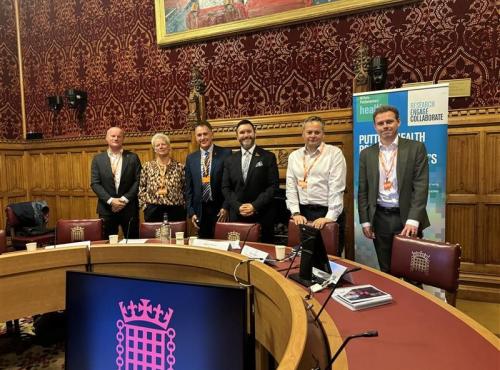Green Labour, Purple Liberals and Red Tories The evolution of party colour schemes
In this blog, Jack Tindale talks us through the differing colours of the political parties, and what the change over time represents.
For all that we associate the Labour Party with red, the Conservatives with blue, and the Liberal Democrats with various shades of orange, a nationwide approach to the design of political parties has only really been in place since the 1980s.
Prior to this, it was common for Conservative candidates to use pink in Norwich, the Liberals periwinkle blue in Cheshire and Carmarthenshire, and even Tony Benn wore a yellow rosette at his election in 1974 as was the tradition for Labour candidates in the West Country.
The colour variations were often down to local identity, in Northumberland and Tyneside, Labour candidates wore green with reasons ranging from a tribute to the Chartist movement, to an association with the region’s Irish Catholic community. Another suggestion, put forward by Stephen Bird of Manchester’s People’s History Museum, suggests that this was actually down to the Durham miners – who disliked red because it was the horse racing colours used by the Dukes of Newcastle.
The Conservatives have also not been immune from such confusion. It wasn’t until 1949 that the National Union of Conservative and Unionist Associations voted to formally adopt blue as the official colour of the party. Even this was not taken forward by many local parties, who continued to use their traditional branding. In Norwich, election agents reported having double the printing expenses of other parts of the country, having leaflets produced in both orange and purple. Before the rise of the Labour Party and the wider socialist movement, the Conservatives (or Unionists) tended to put red at the forefront of their election branding, given its historic association with the Union Flag and the Crown.
Even the Liberal Democrats and the predecessor parties have used a kaleidoscope of branding efforts away from their current official ‘Gold’ of Pantone 1375C (annoying for a post-war party that has often been strapped for cash, this dye is one of the most expensive to buy, necessitating various cheaper shades of yellow-orange being used by more enterprising candidates). An article by Graham Lippiatt in the Journal of Liberal History notes that at the Torrington by-election of 1958, the victorious candidate – Mark Bonham Carter (yes, a close relative of Helena) used purple and orange. Lippiatt cites this as being due to them being the colours of the Robartes family, who were the most prominent local backers of the Parliamentarian cause during the English Civil War, when most of Devon and Cornwall supported the Royalists.
And so today with the party colours firmly established you are unlikely to be confused by party affiliation based on the colour of their rosettes and leaflets. Perhaps that is for the best. As Lippiatt concludes in his article, it may be the best way of avoiding argument. He recounts a debate in the 1950s between the two dominant Liberal women of the era, the left-leaning Lady Megan Lloyd George and her more traditional rival, Lady Violet Bonham Carter (yes, another relation). After going through a number of options for a new national colour for the party executive to use, Lady Megan finally lost patience and snapped that she didn’t care what colour was used, so long as it wasn’t violet!



